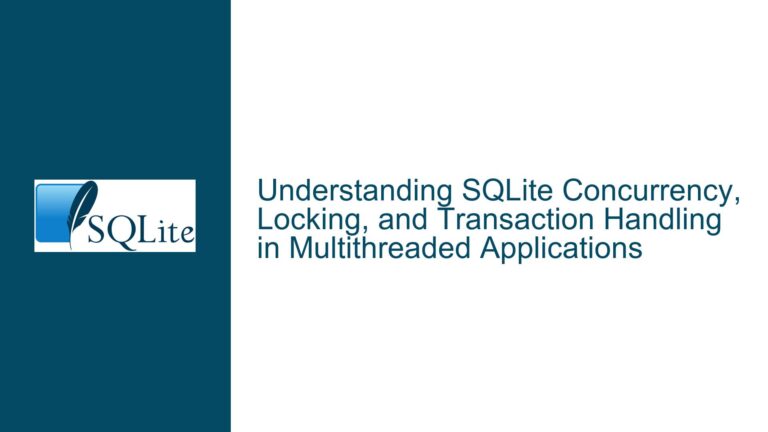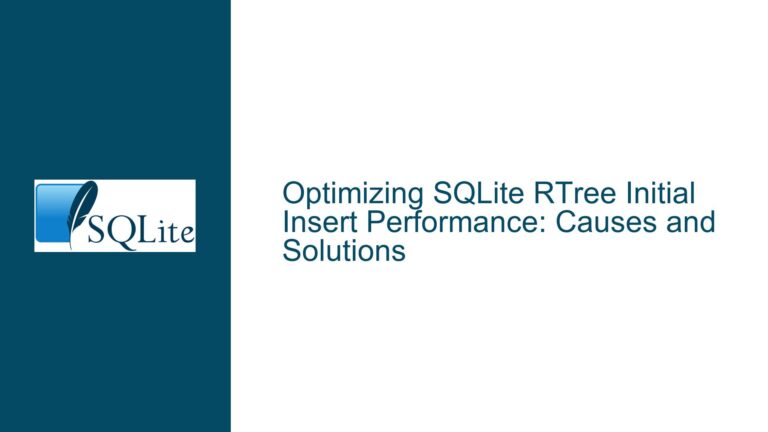Recovering Data Loss in SQLite After Application Crash with PRAGMA synchronous=OFF
Data Loss in Multi-GB SQLite Tables After Application Crash
When dealing with SQLite databases, particularly in high-throughput data acquisition systems, data loss can be a catastrophic event. In this scenario, the database is used to store large volumes of mixed image (BLOBs) and numerical data, with tables growing significantly during the acquisition process. The database is configured with PRAGMA synchronous=OFF for performance reasons, and the application crashes at the end of the acquisition run, leaving behind a multi-GB database file and a journal file. Upon reopening the database, the largest tables are truncated to 0 records, and the database shrinks to approximately 500 kB. This behavior is unexpected, especially given that the application commits transactions every 5 seconds, and the crash occurs after data writing has slowed down to 0.
The core issue revolves around the interaction between SQLite’s transaction management, the synchronous=OFF setting, and the application’s crash behavior. The expectation is that, at most, the last 5 seconds of data would be lost due to the periodic commits. However, the observed behavior suggests that a significant portion of the data is lost, indicating a deeper issue with how SQLite handles transactions and journaling under these specific conditions.
Interrupted Write Operations and Kernel Buffering with synchronous=OFF
The primary cause of the data loss lies in the combination of the synchronous=OFF setting and the application crash. When synchronous=OFF is enabled, SQLite does not wait for the operating system to confirm that data has been written to the physical disk. Instead, it relies on the operating system’s kernel buffers to eventually flush the data to disk. This setting is often used to improve performance, especially in high-throughput systems where write latency needs to be minimized.
However, this configuration comes with significant risks. If the application crashes before the kernel buffers are flushed to disk, any data that was only in the kernel buffers is lost. This is because the data never actually reached persistent storage. In this case, the crash occurs during a period when no new INSERTs are taking place, but the last transaction has not yet been finalized. The journal file, which is used to ensure atomicity and durability of transactions, is also affected by the crash. When the database is reopened, SQLite attempts to replay the journal, but due to the incomplete state of the journal and the lack of synchronous writes, the largest tables are truncated.
Another contributing factor is the application’s crash behavior. If the crash is caused by a bug in the application, it could potentially corrupt the database or the journal file. This corruption could lead to the observed truncation of tables when the database is reopened. Additionally, the crash might interfere with SQLite’s internal state, causing it to misinterpret the state of the database and journal files.
Implementing PRAGMA journal_mode=WAL and Database Recovery Strategies
To address the issue of data loss, several strategies can be employed, focusing on both prevention and recovery. The first and most critical step is to change the journal mode to WAL (Write-Ahead Logging) and set synchronous=NORMAL. WAL mode is designed to provide better concurrency and durability compared to the default rollback journal mode. In WAL mode, writes are appended to a separate WAL file, and the database file is only modified during a checkpoint. This reduces the likelihood of data loss during a crash, as the WAL file can be replayed to recover committed transactions.
To implement WAL mode, the following PRAGMA statements should be executed when opening the database:
PRAGMA journal_mode=WAL;
PRAGMA synchronous=NORMAL;
This combination ensures that SQLite will wait for the operating system to confirm that data has been written to the WAL file before considering a transaction committed. While this may introduce some performance overhead, it significantly reduces the risk of data loss during a crash.
In addition to changing the journal mode, it is essential to ensure that the application commits transactions more frequently. While the current setup commits every 5 seconds, reducing this interval can further minimize the amount of data lost in the event of a crash. However, this must be balanced against the performance impact of more frequent commits.
For recovery, if the database and journal files are still available after a crash, several steps can be taken to attempt data recovery. First, the database file should be copied to a safe location to prevent further data loss. Next, the journal file should be examined to determine its state. If the journal file is incomplete or corrupted, it may not be possible to recover the lost data. However, if the journal file is intact, it can be replayed manually to recover as much data as possible.
To manually replay the journal, the following steps can be taken:
- Create a backup of the database and journal files.
- Open the database in SQLite and attempt to replay the journal using the
PRAGMA journal_mode=DELETEcommand. - If the journal replay is unsuccessful, use the
.dumpcommand to export the database schema and data to a SQL script. - Examine the SQL script for any missing data and attempt to reconstruct the lost data from other sources.
If manual recovery is not feasible, commercial database recovery tools can be used. However, as noted in the original discussion, these tools may not be able to recover the lost data if the journal file is incomplete or corrupted.
Finally, to prevent future data loss, it is crucial to address the root cause of the application crash. This may involve debugging the application to identify and fix any bugs that lead to crashes. Additionally, implementing robust error handling and logging can help identify issues before they lead to data loss.
In conclusion, the combination of synchronous=OFF and an application crash can lead to significant data loss in SQLite databases. By changing the journal mode to WAL, increasing the frequency of commits, and implementing robust recovery strategies, the risk of data loss can be significantly reduced. Additionally, addressing the root cause of the application crash is essential to ensure the long-term stability and reliability of the data acquisition system.






